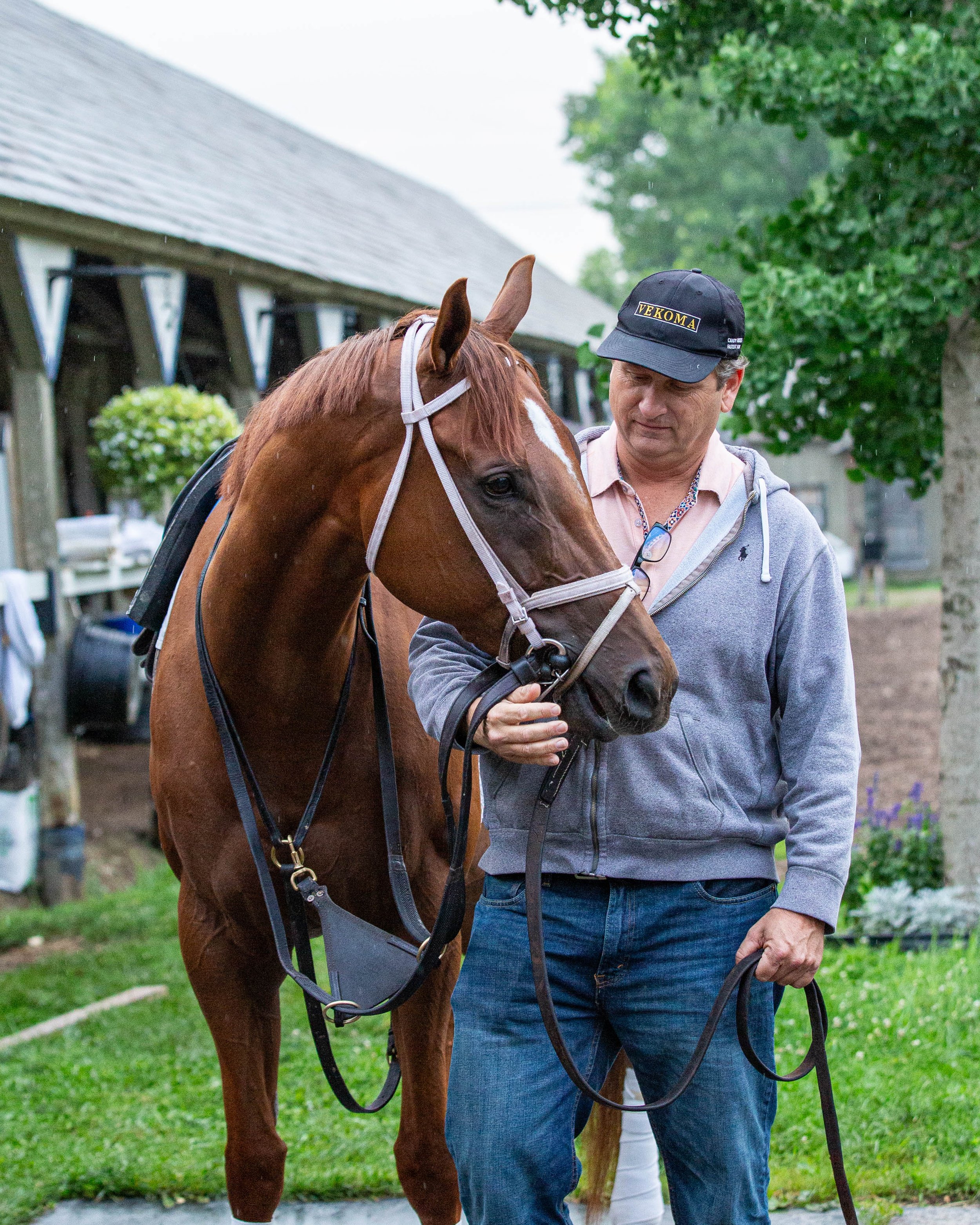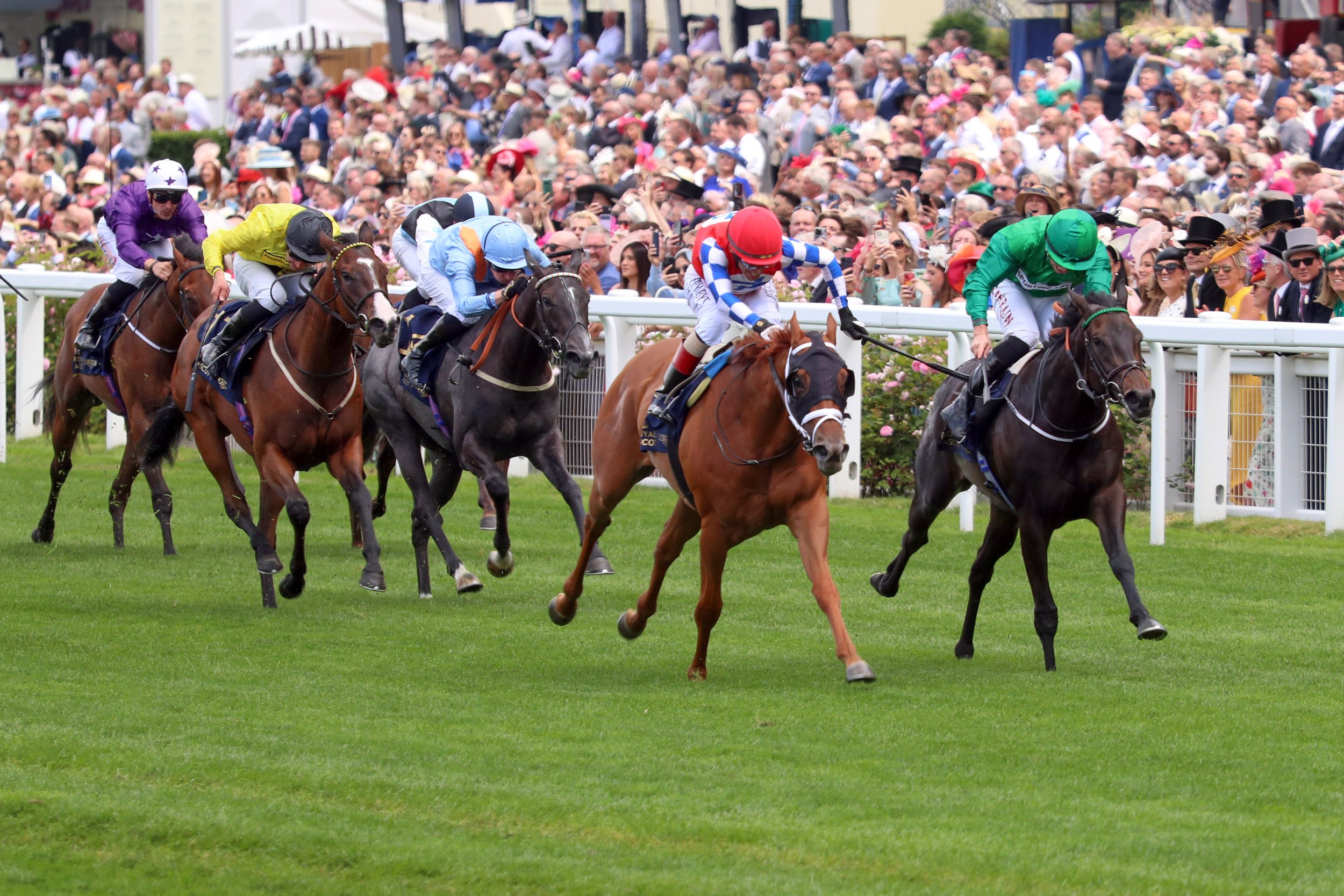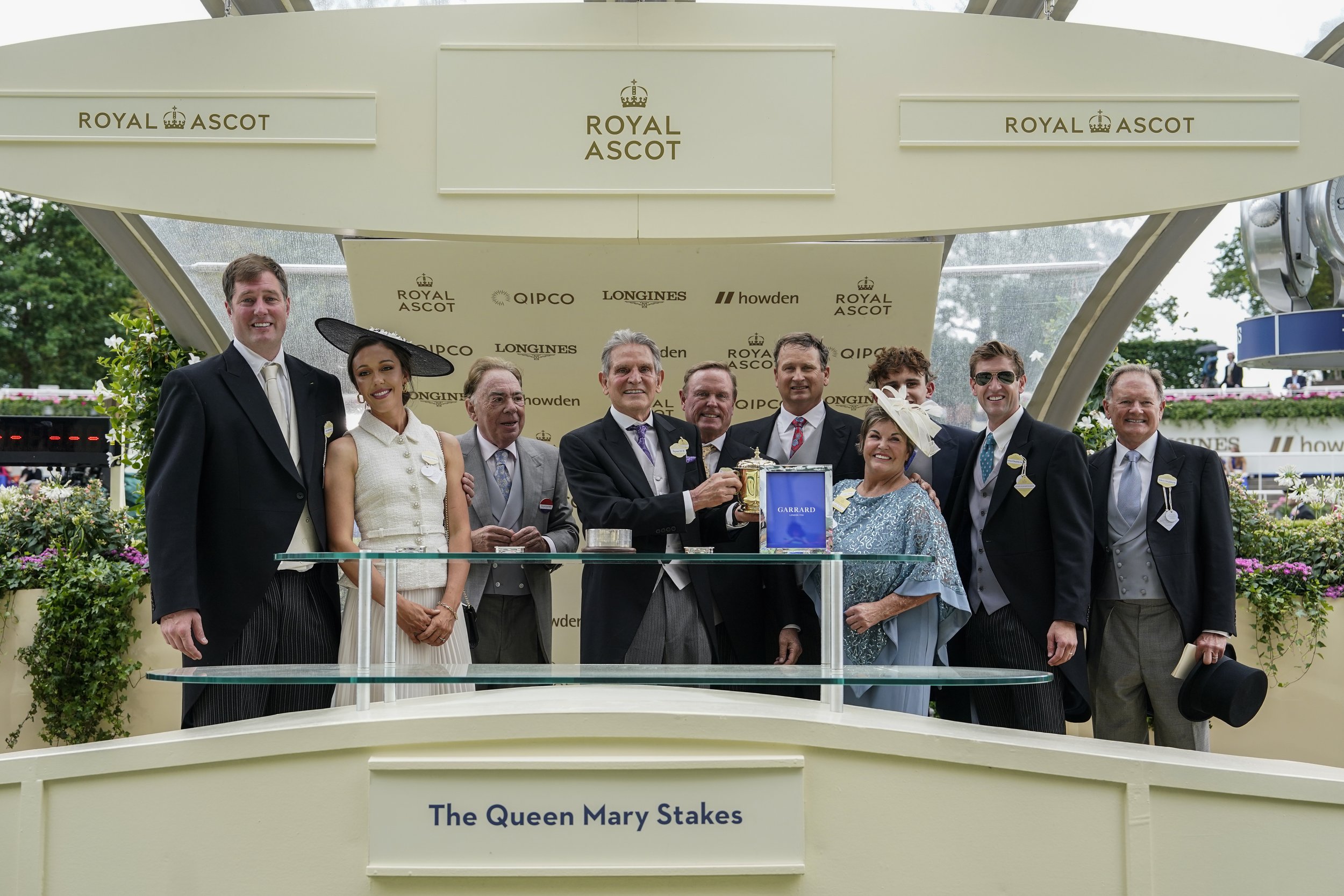George Weaver - Champagne still flowing!
Article by Bill Heller
Eight years removed from his first unsuccessful starter at Royal Ascot, trainer George Weaver was already a winner when his two-year-old filly Crimson Advocate stepped onto the track to contest the Gp. 2 Queen Mary Stakes June 21. That’s because his love, his partner and his best friend, his wife Cindy Hutter, was able to accompany him and their 20-year-old son Ben to England nearly one year after her gruesome injury on the Oklahoma Training Track at Saratoga Race Course. A horse she was galloping suffered an apparent heart attack and collapsed on her, causing severe brain damage and multiple injuries—changing their lives forever.
Imagine their joy when a photo finish showed that Crimson Advocate and Hall of Fame jockey John Velazquez, had won the Queen Mary Stakes by a fraction of a nose, making Weaver just the third American trainer to capture a race at England’s most prestigious course, in a field of 26. “It was very, very emotional for us,” Weaver said. “ It was kind of miraculous—a beautiful experience much more than winning a race at Ascot. It was kind of spiritual.”
Cindy said after the race, “It was kind of like a dream come true.”
It happened 12 days short of one year after the nightmare at Saratoga.
Weaver was walking back to the barn with another horse when Cindy went down. “By the time I got there, the ambulance was there,” he said. “She was unconscious. She was bleeding. It was a bizarre day. It was a very scary day. It was a very stressful time. We didn’t know if she was going to regain consciousness. We didn’t know what the future would hold.”
Cindy had suffered broken ribs, a broken collarbone and a lung injury besides bleeding on the brain. Though seemingly unconscious, she was able to give a thumbs-up sign after hearing a voice command from a doctor. There was reason for hope.
Hope can go a long way. No one envisioned Weaver and Cindy standing in the winner’s circle at Royal Ascot less than a year later. “We’ve been doing this our whole lives,” Weaver said. “It was an exciting day for us.”
Weaver, 53, was born and raised in Louisville and knew at a very young age that his life would involve Thoroughbreds. He thanks his father, Bill, for that. “My dad took me to the track and told me how to read the Form since I was very little—less than a year old. It was exposed to me early on, and it stuck with me.”
His brother, Scott, went to the track with him, but after working briefly with horses, he turned to business and works for a computer company.
Weaver has never left the business. “I was never really in doubt about what I wanted to do,” he said.
He worked on a farm briefly for Kenny Burkhart but didn’t take long to know he wanted to work at the track. While still in high school, he began walking hots for trainer John Hennig in the summer. “I was 17,” Weaver said. “I told him I didn’t want to be a hotwalker. I wanted to learn. He took me to Philadelphia Park. He taught me how to be a better hotwalker, how to groom and horsemanship.”
When Hennig left to work for Hall of Fame trainer D. Wayne Lukas at a training center in California, Weaver was given a choice in 1991: go to California and work for Hennig or travel to New York to work for Lukas’ New York operation under Jeff Lukas and Hall of Famer Todd Pletcher.
“Working for Wayne, he had some very, very nice horses,” Weaver said. “It was a source of pride to come out of that program, learning to train horses. It’s a lot of trial and error. That was my schooling as opposed to college. I went to the University of Wayne Lukas.”
Lukas remembers both Weaver and Cindy fondly: “The two of them were both working for me at the same time. It was a treat to have them in the shed row. Both excellent horse people. I never doubted for a second they’d be successful. He’s an articulate, good horseman. I’m very proud of him. I saw him on TV at Ascot. It was a treat to see him over there. If George doesn’t do anything else, he married smart.”
Cindy, a native of Romansville, Pennsylvania, began riding at an early age and began working for Bruce Miller when she was 16. She galloped horses at Delaware Park and, in her early twenties, began working for Lukas in New York.
It was not love at first sight. They knew each other for years before they began dating. They’ve been together ever since. His respect for her horsemanship is considerable: “She could be on her own… attention to detail…perfectionist. Over the years, she could help a horse who was nervous or a head case. She was always our go-to girl. She’d fix them. I can’t tell you how. She has a great instinct for a horse. She’s a great rider. She’s one of a kind. I don’t think I’ve ever seen anyone like her.”
When they learned Cindy was pregnant, they decided to go on their own in 2002. “It was time to make a go for it,” Weaver said. “It was time for me to give it a go: come together as a family and see how it went. Luckily, we’ve had a lot of success over the years. She managed the barn so I could focus on our clients. We’ve always worked well together and done well.”
Always? A husband and wife together 24/7? “I won’t lie to you; she has strong opinions,” Weaver said. “Obviously, you have clashes. But we have a mutual respect. It starts with that. We both have the same philosophy: keeping the horses happy.”
Cindy agreed: “We keep horses happy. We do little things like take them to the round pen, let them graze, let them walk and do things before they even go to the track. I think little things make a difference. And we do well together. He gets to do more with the owners and the PR part. I’m more the worker with the horses. We both have our say, and it seems to work that way.”
They didn’t take long to find success. After winning one of eight starts in 2002, they topped the million-dollar mark in earnings in 2003 and have been over a million every year, including this year, already, thanks to a solid career win percentage of 15.
His top earner and best horse was Vekoma, whose six-for-eight record included victories in the 2020 Gr. 1 Metropolitan and Gr. 1 Carter Handicap. He earned $1,245,525 and is now standing at Spendthrift Farm.
In 2015, Weaver took a shot at Royal Ascot, sending over Cyclogenesis to contest the Gp. 1 Commonwealth. “He was three-for-three at the time,” Weaver said. “A big heavy horse. He was a nice horse. It just wasn’t his day over there.”
Cyclogenesis finished 14th.
His performance did nothing to diminish Weaver’s appreciation of the experience: “When you get there, it’s clear how special the racing is at Royal Ascot. I was amazed at the place. It’s a hard place to win. I thought when I left in 2015, how cool it would be to win a race there. It’s like a bucket list.”
Crimson Advocate ridden by John Velazquez claimed the narrowest of victories in a thrilling climax to the 2023 Queen Mary Stakes at Royal Ascot.
The filly who would bring him back was Crimson Advocate, a daughter of Nyquist out of Citizens Advocate by Proud Citizen. Crimzon Advocate was purchased for $100,000 at the Ocala Breeders October Yearling Sale by a large ownership group led by Randy Hill, who owned Vekoma and has been sending Weaver horses for 20 years. Other owners are St. John’s University’s new basketball coach Rick Pitino, New York Giants senior personnel consultant and New York Racing Association Board of Directors Chris Mara, Reagan Swinbank, Bill Daugherty of Black Ridge Stables and Jake Ballis of Black Type Thoroughbreds.
Crimson Advocate would make her debut at Keeneland on dirt April 26, well after Cindy had made major strides in her recovery—something she continued after four months in a hospital.
An unending outpour of support and prayers, especially from horsemen, certainly helped. “It’s a tight-knit group,” Weaver said. “We’re motivated by our love of horses. You can’t do this without loving horses. When she got hurt, it’s a hard thing to go through. It was scary for quite a few months. So many people reached out. It felt good to have the racing community reach out and pull for us and let us know how much support we had out there. It’s been a tough road. We couldn’t have done it without help. There’s a lot of love on the racetrack, and we really appreciate it. This happened a year ago. We’re fortunate that Cindy made a good recovery. She’s still Cindy. We take things one day at a time.”
Crimson Advocate finished an okay third in her 4 ½ furlong maiden debut on dirt at Keeneland. Her next start, her turf debut at Gulfstream Park, was in the Royal Palm Juvenile Filly Stakes. Through a unique partnership between Gulfstream Park and Ascot, the winner of that stakes and the Royal Palm Juvenile Stakes became automatic qualifiers for the Royal Ascot two-year-old stakes race and $25,000 in traveling expenses.
Weaver won both stakes. Crimson Advocate won the filly stakes wire-to-wire by 3 ½ lengths. No Nay Mets, whose ownership includes Houston Astros star Alex Bregman, captured the colt stakes. He raced at Ascot the day after Crimson Advocate and finished 9th in the Gp. 2 Norfolk Stakes.
With two starters at Ascot, Cindy had added incentive to make the trip, if she was up to it. “We went to Aspen before Ascot,” Weaver said. She handled that and headed to England with her family.
Crimson Advocate’s new rider would be Velazquez. In a field of 26, his expertise and experience were paramount.
Watching a field of 26 two-year-old fillies racing five-furlongs on a straight course is an interesting experience. There were two distinct groups during the race far away from each other on the course. How a jockey can make judgment calls with that challenging perspective is a skill itself. Fortunately for Velazquez, he was in a sprint with two-year-olds. She would go as fast as she could.
She broke from the rail nearest the grandstand, and Velazquez hustled her to the lead. She seemed in good shape as her group seemed ahead of the other group. But then Relief Rally came flying at her late. They crossed the wire together.
“I didn’t know if I got it or not,” Velazquez said afterwards.
Weaver, as his custom, assumed the worst: “Usually, when it’s that tight, I assume we got beat, just to prepare myself. After that, I watched a slo-mo replay. While watching that, I thought she might have gotten the bob.”
She had. Her number was posted first on the toteboard. “We were just out of our minds, hugging, kissing, on cloud nine,” Weaver said.
Hill told Bob Ehalt of Blood-Horse, “It was great. It was so emotional. Cindy was there, and she was crying. I couldn’t get over it. I am so glad for George. We’ve been together for so long and have won some big races together. I know how much this meant to him.”
Just getting to Ascot meant a lot to Weaver and Cindy. “She saw a lot of people she hadn’t seen in a while,” Weaver said.
Cindy said, “I had to really try hard and be strong to try to make this trip,” she said. “I was just hoping that she wound show up and run a good race.”
While waiting out the results of the photo finish, she said, “If she was second, it was okay. I knew she gave her best.”
So did Cindy.
#Soundbites - Should rules be added to limit or eliminate a jockey’s use of the whip?
#Soundbites
Compiled by Bill Heller
Robbie Davis
Yes. When a horse is beat, he shouldn’t be beaten up. Horses are competitive for the most part. Once they’re tired, you’re not going to get any more out of them. Or if he’s winning by several lengths, he shouldn’t be getting hit. It doesn’t take long to look right, look left and see how far ahead you are. I’ve seen the whip do more trouble than not. You’re not supposed to steer with the whip. That’s what the reins are for. In Canada, they limit the number of hits from the quarter-pole home and you can’t go above your head to whip.
Carla Gaines
It’s interesting. At this stage, the whip is so soft. Here in California, our sticks are as soft as can be. We used to use a stick which was far more severe for decades. It left welts. I rode horses all my life. I think the stick is necessary. You’re sitting on top of an explosive, thousand-pound animal. The stick will help control the horse. A lot of people advocate no stick. I understand that public concern is we’re hitting the horse, but it’s used to control the horse. People who work with other animals know you have to have some sense of control, not abuse. You have to keep them going in a straight line, or they could endanger somebody’s life.
John Velazquez (Hall of Fame Jockey)
We have rules already, but there are different rules. Would uniform rules be nice? Yes. But we talk about it, and nothing happens. It would be nice to see it happen before I retire. About eliminating the whip, absolutely not. It’s a tool we need. We need something to get the horse’s attention. We need it to get horses to go straight. Also, horses need to be encouraged. I’m not concerned about the perception because we use new whips that are much softer, much different now than the ones we used to use.
Jeremiah Englehart
I can see a limited use of the whip to a certain degree. I like what Ramon’s (Dominguez) whip has done. I think from before, the old whips, you would get more whelps. With Ramon’s whip, it will be enough to get a horse’s attention. There are times when the whip has a good use. With a green horse, you’re trying to keep everyone on the racetrack safe. They’re not going to run in a straight line all the time. The use of the whip is necessary. I don’t think eliminating the whip is the answer. There should be panel looking at it with riders involved.
TO READ MORE —
BUY THIS ISSUE IN PRINT OR DOWNLOAD -
Summer 2019, issue 53 (PRINT)
$6.95
Summer 2019, issue 53 (DOWNLOAD)
$3.99











